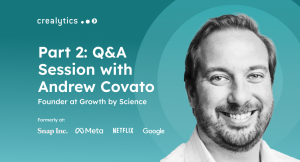It can be tempting, when measuring the success of your search marketing campaigns, to judge them based simply on your Return on Advertising Spend (ROAS). Or, you might want to concentrate solely on winning new customers and measure your campaign success by cost per new customer or just the number of new customers.
But, we think the true value of your campaigns is slightly more complicated. Gaining lots of new customers might sound great, but they can be very expensive to attract. And let’s not forget about returning customers. Sure they may not spend as much per purchase as new customers, but you wouldn’t want them buying a competitor’s product.
To truly understand, and be able to optimize, the value of your search marketing campaigns, you need to calculate the Lifetime Return on Investment (ROI) of each market or campaign. CLV is primarily driven by two factors:
- Expected market specific lifetime values (Customer CLV)
- Campaign efficiency based on marketing investment (ex. ROAS)
A unified approach is essential to know how much you should be investing in retention vs new customer acquisition. Let’s look at each of those factors, in turn, starting with Customer Lifetime Value (CLV).
Figuring out your Customer Lifetime Value
A customer’s Lifetime Value (LTV) is the projected net margin (ie after returns) they will generate over a defined period (usually 12 or 24 months), churn being considered. The two biggest factors that contribute to this value are their Purchase Frequency – how many times they will buy from you – and their Average Order Value (AOV) – how much they will buy from you.
Customer churn is the reason you can’t put all your marketing efforts into attracting new customers. Marketing to existing or past customers is just as important to keep them engaged with and interested in your products.
Of course, if you have strong Customer Relation Management (CRM) and Retention Strength, you will have far less churn and will be able to invest more of your marketing budget in acquiring new customers.
Finding the ideal balance between customer retention and acquisition is why calculating CLV is so important. Knowing at what point a customer becomes profitable, is an essential part of knowing how much budget you can allocate to a particular channel or a market.
Adding you current marketing efficiency to CLV
As we’ve just shown you, customer CLV is calculated over a long period – usually 24 months. But, to get an accurate Lifetime ROI, you also need to know how efficient your current marketing strategies are.
To do this, you measure two things:
- Return on Advertising Spend (ROAS) – how much profit you are generating from every dollar you spend on advertising
- New Customer Rate (NC-rate) – how quickly you are gaining new customers
Both ROAS and NC-rate can be calculated for different advertising criteria.
Calculating Lifetime ROI
The actual calculation for Lifetime ROI would also include margins and channel incrementality – a bit too much to cover in a single blog post – but the general principle is that you combine your monthly returns (ROAS) with your projected returns for new customers (LTV) and subtract your marketing spend. You might be able to improve New Customer Rate by shifting budgets to different ad inventory (or product) or by excluding existing customers from your ad serving – but that’s a topic for another time.
In this Lifetime ROI scenario, you are, in a sense, “trading” New Customer Rates against ROAS efficiency. The more new customers you win, the further you can allow ROAS to fall and still break even against your marketing spend.
For our retail clients, we not only measure NC-rates and ROAS per market but, given enough data points, we can figure out which products are most attractive to new customers. These products are what we call door openers, and many retailers choose to invest more in advertising them.
Unified Lifetime Value Calculation
Remember that this type of calculation isn’t just applicable to different markets. You can run the same Lifetime ROI calculation for every different product offering within each market and channel. When you combine all those calculations you reach a Unified Lifetime Calculation (ULC) that automatically balances new customer acquisition and retention.
Growing businesses can use the Unified Lifetime Calculation to compare budget scenarios and answer questions like:
- What is the greatest number of new customers I can attract if I want to break-even after 12 or 24 months?
- What is the maximum share of voice I can reasonably achieve?
Armed with that kind of information, you can make smart, targeted decisions about which products in which markets and on which channels should get the most attention for the greatest positive result.




